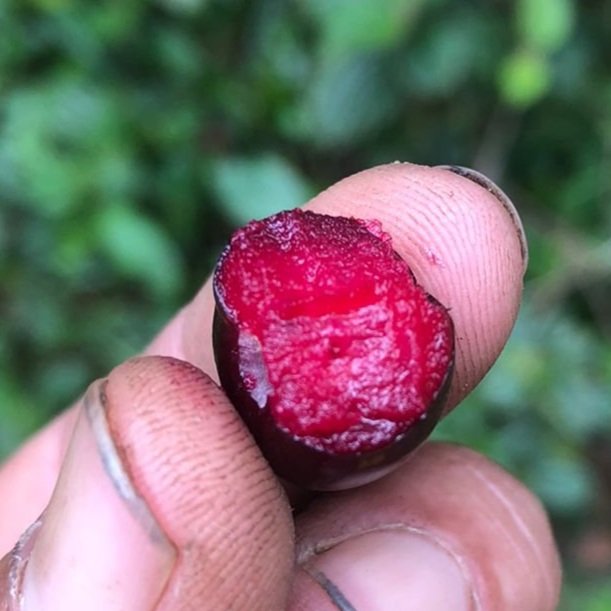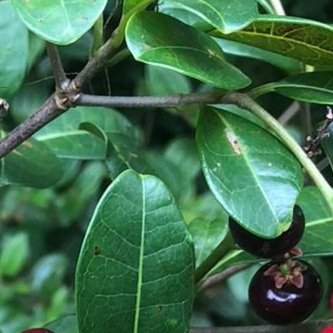Byrsonima Ligustrifolia var Black
Seeds were imported from Brazil. Seeds were imported from Brazil. Occurs on the coastal edges of the Atlantic Forest or in swamps from Minas Gerais to Santa Catarina, Brazil. Medium-sized tree, branched from the base, reaching 4 to 7 meters tall, with a dense, branched rounded crown. The tree is very similar to the tubercula (Pera glabrata ). The adult trunk is rough and whitish gray in color. The light green leaves are simple, cartaceous (like cardboard), and with interpetiolar stipula (type of modified leaf); They are also oblong (longer than wide), measuring4.5 to 8.5 cm long by1.6 to 2.2 cm width. The base is cuneate (wedge-shaped), and the apex is rounded. The flowers are white with light pink edges, numbering10 to24 flowers arranged in racemes (a type of cluster with a central stem) of6 to 9 cm of length. The fruits are rounded doubles of0.8 to 1.5cmin diameter. Fast-growing tree, enjoying red and clayey soils that maintain good humidity or preferably marshy soils with plenty of water. This species has a neutral pH between5.6 to6.8. The plant is resistant to droughts of up to 3 months and frosts of up to -1 degree, without any damage to the plant. It can be grown at any altitude and cannot be missed from reforestation projects, as its fruits are highly appreciated by birds and various animals. Starts fruiting with3 to5 years after planting. The fruits are consumed fresh and have a taste like currants and can easily be pulped for later use in juices with a highly appreciated color and flavor. The flowers are beekeeping, and the fruits attract different types of birds that swallow them whole and thus disperse the seeds. This is a variation of the regular Byrsonima Ligustrifolia that produces Black fruits. Seeds are shipped in vermiculite.
Seeds were imported from Brazil. Seeds were imported from Brazil. Occurs on the coastal edges of the Atlantic Forest or in swamps from Minas Gerais to Santa Catarina, Brazil. Medium-sized tree, branched from the base, reaching 4 to 7 meters tall, with a dense, branched rounded crown. The tree is very similar to the tubercula (Pera glabrata ). The adult trunk is rough and whitish gray in color. The light green leaves are simple, cartaceous (like cardboard), and with interpetiolar stipula (type of modified leaf); They are also oblong (longer than wide), measuring4.5 to 8.5 cm long by1.6 to 2.2 cm width. The base is cuneate (wedge-shaped), and the apex is rounded. The flowers are white with light pink edges, numbering10 to24 flowers arranged in racemes (a type of cluster with a central stem) of6 to 9 cm of length. The fruits are rounded doubles of0.8 to 1.5cmin diameter. Fast-growing tree, enjoying red and clayey soils that maintain good humidity or preferably marshy soils with plenty of water. This species has a neutral pH between5.6 to6.8. The plant is resistant to droughts of up to 3 months and frosts of up to -1 degree, without any damage to the plant. It can be grown at any altitude and cannot be missed from reforestation projects, as its fruits are highly appreciated by birds and various animals. Starts fruiting with3 to5 years after planting. The fruits are consumed fresh and have a taste like currants and can easily be pulped for later use in juices with a highly appreciated color and flavor. The flowers are beekeeping, and the fruits attract different types of birds that swallow them whole and thus disperse the seeds. This is a variation of the regular Byrsonima Ligustrifolia that produces Black fruits. Seeds are shipped in vermiculite.
Seeds were imported from Brazil. Seeds were imported from Brazil. Occurs on the coastal edges of the Atlantic Forest or in swamps from Minas Gerais to Santa Catarina, Brazil. Medium-sized tree, branched from the base, reaching 4 to 7 meters tall, with a dense, branched rounded crown. The tree is very similar to the tubercula (Pera glabrata ). The adult trunk is rough and whitish gray in color. The light green leaves are simple, cartaceous (like cardboard), and with interpetiolar stipula (type of modified leaf); They are also oblong (longer than wide), measuring4.5 to 8.5 cm long by1.6 to 2.2 cm width. The base is cuneate (wedge-shaped), and the apex is rounded. The flowers are white with light pink edges, numbering10 to24 flowers arranged in racemes (a type of cluster with a central stem) of6 to 9 cm of length. The fruits are rounded doubles of0.8 to 1.5cmin diameter. Fast-growing tree, enjoying red and clayey soils that maintain good humidity or preferably marshy soils with plenty of water. This species has a neutral pH between5.6 to6.8. The plant is resistant to droughts of up to 3 months and frosts of up to -1 degree, without any damage to the plant. It can be grown at any altitude and cannot be missed from reforestation projects, as its fruits are highly appreciated by birds and various animals. Starts fruiting with3 to5 years after planting. The fruits are consumed fresh and have a taste like currants and can easily be pulped for later use in juices with a highly appreciated color and flavor. The flowers are beekeeping, and the fruits attract different types of birds that swallow them whole and thus disperse the seeds. This is a variation of the regular Byrsonima Ligustrifolia that produces Black fruits. Seeds are shipped in vermiculite.




